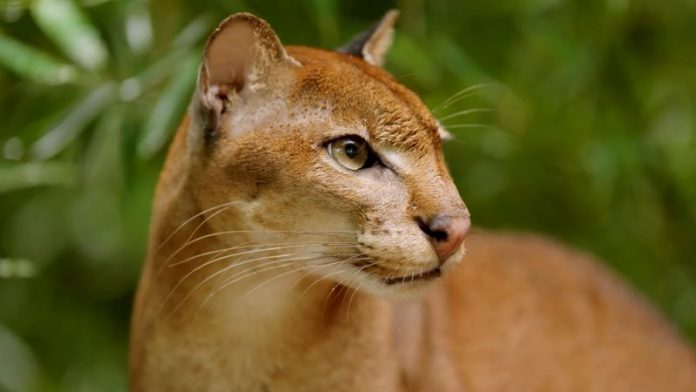The first time Mwezi Mugerwa saw the African golden cat, he didn’t know what it was.
While reviewing camera trap footage at Uganda’s Bwindi Impenetrable Forest National Park, the conservation biologist spotted an unfamiliar creature around twice the size of a domestic cat in the grainy black-and-white footage.
None of his colleagues could identify it; “but, when I talked to the hunters and communities who lived around the park, they knew the species,” Mugerwa recalls.
Known as Embaka in the local language, the “cryptic” golden cat was often caught accidentally in forest snares.
“That was really concerning for me — that we may lose this species before we even get to know about it,” says Mugerwa.
Over the past 16 years, Mugerwa has dedicated his career to “Africa’s least known, least understood, least studied big cat.” Found in dense tropical forests across Central and Western Africa, the species is so elusive that the last IUCN assessment — over a decade old — has no population estimates, and in all his years of fieldwork, Mugerwa has only managed a fleeting glimpse of the African golden cat three times with his own eyes. The International Union for Conservation of Nature (IUCN), the world’s largest environmental network of government and society organizations, tracks threatened wildlife.
“They’re really, really difficult to see in the wild,” says Mugerwa, who won the Indianapolis Prize Emerging Conservationist Award earlier this year for his work on the species.
But, realizing that accurately counting the big cats was the first step to protecting them, he set out to conduct the first population census across the species’ range, expected to publish next year.
Mugerwa knew that gathering data on the African golden cat wasn’t something he could do on his own. So, in 2019, he founded the African Golden Cat Conservation Alliance (AGCCA), a network of 46 conservationists across 19 countries.
Together, they launched a standardized camera trap survey across the cat’s suspected range, supported by funding from the National Geographic Society.
But manually reviewing thousands of images from 30 sites across 19 countries — the largest camera trap grid for any African wildlife species, says Mugerwa — “was really, really painful.”
At the same time, US-headquartered nonprofit Panthera, another of Mugerwa’s collaborators, was developing an AI algorithm that could quickly sort the images and identify individual cats based on their unique coat patterns, similar to how tiger stripes are used like fingerprints.
“That’s really important, because now we are able to speak to number and density,” says Mugerwa, adding that without AI, distinguishing individual cats would be nearly impossible due to their small size and subtle markings.
Preliminary data suggests the species exists at low densities — even in protected habitats. In Uganda and Gabon, for example, surveys found just 16 individuals per 100 square kilometers.
The surveys have also revealed the true impact of poaching: in areas with hunting restrictions, Mugerwa says cat populations were up to 50% higher, with wider distribution. The study has also observed that while the cats are active both day and night, many are strictly nocturnal — likely to avoid human activity during the day, he adds.

Establishing population numbers was just the first step. Early in his research, Mugerwa realized that hunting was the cat’s primary threat.
In East Africa, where Mugerwa is based, the African golden cat is rarely the target of hunters. But bushmeat snares, set for pigs and antelopes, are indiscriminate, often catching other species unintentionally. In 2019, Mugerwa received reports of 80 golden cats caught in snares in three Ugandan forests, 88% of which were accidental.
“We are dealing with a bushmeat crisis: the level of hunting ongoing in this forest is unsustainable and out of control,” he says, adding: “The species is being pushed to the edge of extinction in many of its range countries.”
To combat the cat’s biggest threat, Mugerwa went directly to the residents, creating Embaka: the first community-based anti-poaching conservation project focused on the African golden cat.
Working with over 8,000 families across the cat’s range, including Gabon, Angola, the Democratic Republic of Congo, South Sudan, and Uganda, the project engages local communities — many of whom are former poachers — to deploy camera traps and report sightings.
“We have learned a lot from local communities; the range expansion, for instance, some of that data comes from hunters,” says Mugerwa. Embaka offers incentives like dental care and livestock support to encourage communities to “speak out against hunting” and protect the forest ecosystem.
Bringing reformed hunters on board not only reduces the threat the cats will face from hunting, but it also “improves the relationship between the African golden cat and the communities,” says Mugerwa.
“It also allows the local communities to own and to be part of the camera trap grid, which is really beautiful to see,” he adds.







